|
Día de Publicación:
|
Enviar a:
|
INGLES / ENGLISH
By: Dr. David William Foster, Arizona State University
Especially for Culturadoor
Pictures from the author’s personal collection
The first impression one receives upon turning onto East Sherman Street from South 7th Street in downtown Phoenix is that of entering, if not a gated community, a limited access one. The compact Sherman street area (and Sherman street only runs a few blocks east from Van Buren) is all that is left of the once thriving Chicano barrios (actually, in pre-ethnic movement days, Mexican barrios) known as El Campito, which ran along nearby Buckeye east of 7th Street (Buckeye is immediately south of Sherman, with Tonto Street in between them), and Las Milpas, south of Buckeye along 12th Street. The remaining area is known by the City of Phoenix as Nuestro Barrio. Nuestro Park still remains a bit south of Buckeye off of South 8th Street, as does the Barrios Unidos Park off of 14th Street and a few block farther south; both of these parks still do have residential neighbors hoods around them (1).
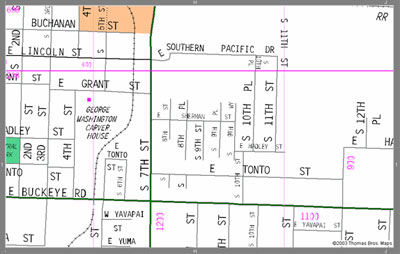
However, this entire area has been undergoing for the past several years acquisition by Phoenix Sky Harbor International Airport, one of the busiest airports in the nation, as befits the fifth largest area concentration in the United State. Sky Harbor is most notable for being one of the few major urban airports located within minutes of the downtown federal/state/county/municipal complex and the original financial and commercial center of Phoenix. Although the city has gone through considerable sprawl in recent decades, Sky Harbor remains the only major commercial airport, and it has resisted the efforts of other airports in the area to service regularly scheduled flights. Thus, as the city has grown, the airport has grown with it, and if historically its development meant sacrificing a considerable swath of ethnic neighborhoods that dated back to the years when nonwhites were essentially required to live south of the downtown area, in classic terms, on the other side of the railroad tracks (Southern Pacific, in this case), continued growth means the acquisition, displacement, and destruction of additional neighborhoods to the west of the existing airport. Although these neighborhoods lie across the Interstate 10 (the so-called Papago Freeway) from the existing runways, they will eventually have to be developed to handle increasing traffic and increasingly larger planes.
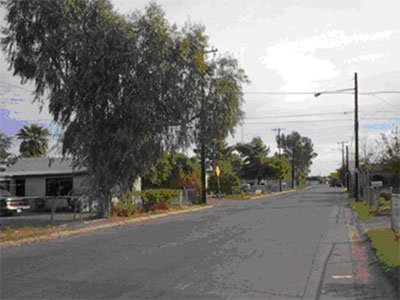
The idea of a limited-access community, in the sense of planned developments that essentially shut off access to a residential area to all but residents and invited guests in a process that is meant to enhance security, is a rather comical one when applied to an area that has become isolated through surrounding—and engulfing—commercial development, and one, to boot, that is destined within the near future, to be bulldozed out of existence. Yet the intent, in using the term, is to underscore the ironic way in which, because of such development, the Sherman Sreet area has become in effect a small residential enclave, as much forgotten by city growth as it is isolated by those circumstances, with the result that it currently functions with a restricted access that has occurred by happenstance and not as the consequence of any residential master plan.
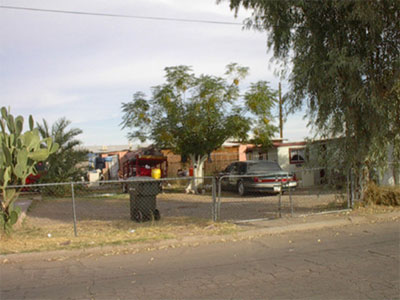
The area reveals very immediately its ethnic history. Many of the houses have yards and gardens that are enclosed by a chain-link fence, a detail that probably serves less a security function than as an emphatic definition of property limits, emphasizing the extent to which Chicano life in the Southwest is lived as much outdoors as indoors. That is, the house, the porch/veranda/gallery, the yard, and the garden function as one continuous living space for what may typically be a large extended family. If the Arizona weather is propitious for such an arrangement during many parts of the year, the customary lack of refrigeration air conditioning may often make the house more sweltering (or more frigid) than the outside areas. Additionally, the customarily modest size of the dwelling necessitates outdoor storage of many of the trappings of modern life: abundant children’s toys are an example, including tricycles, bicycles, scooters, and the like. The reason that the entrance to the Sherman Sreet/Nuestro Barrio area affords the impression of a restricted-access community is because it is surrounded by commercial properties that impose deadends on all but one of its streets. In both directions north and south, South 8th Street, South 8th Place, South 9th Street, South 9th Place, after the equivalent length of one or two blocks, deadend at commercial sites. Only South 9th Way, which deadends both north and south also, connects before it deadends on the south with East Hadley Street, which connects in turn with South 10th Street to the south, South 10th Place and South 11th Street to the north, before deadending itself. The area is small and well aintained. If one were to hear about the existence of such a forgotten barrio and were to assume that it is a collection of unkempt residence scattered along unpaved and dirty roads, it would be a sorely mistaken conclusion: if some of the traditional residential neighborhoods of Tucson have wished to retain dirt roads as the mark of a rustic past, there remain few such areas of Phoenix with unpaved roads, and even ethnic enclaves such as Nuestro Barrio, quite lost in the urban development of the city and, indeed, condemned to disappearance, have paved streets, if not sidewalks.
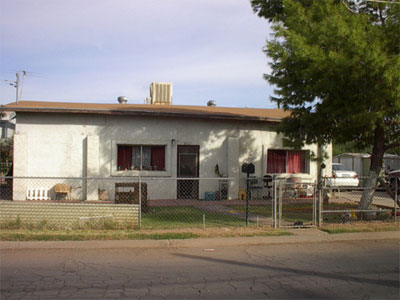
The residences of Nuestro Barrio display very pronouncedly the Chicano custom of defining the property by a chain-link fence, which usually means something no more than three-feet high. Running along the outermost street edge of the property, the effect is very much to produce the impression of a residential preserve that is distinctly separate from its neighbors on all sides and stands very much apart from the public arena of the street, which may have its own characteristic life, such as the circumstantial traffic, the organized traffic of lowriders and cruisers, or, on the dead-end streets, pick-up sports activities.
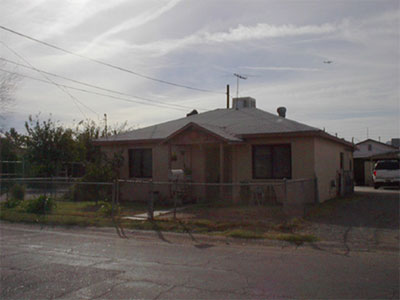
One can readily identify the variegated life that exists on the inside of the defining line of the fence, marked here by the two-gate access to the property. In the first place, vegenation, which might, were their sidewalks, be part of the décor of the vehicular and pedestrian area, is here confined to the inside of the property, as cactus. Bushes, and trees provide color, visual variety, and shade to the property. Second, the property reveals the haphazard growth of the structure that inhabits it, with what appears to be additions to additions, with different colors and multiple accesses marking the added structures. Such a configuration reflects both the modest resources for such renovations and also the way in which they become necessary with the growth in the number of inhabitants, as much on the basis of the basic principle of the extended Latin American family as it is the consequence of the extension of such a family by virtue of the arrival of new immigrants from Mexico. The way in which swelling and changing family members may often by an integral part of a particular resident is what feeds a certain Anglo racist fantasy to the effect that all Chicano households are potential coyote smuggling operations, when there are in fact the reflex of strategies of survival of lower-income families—regardless of their ethnic origin—in a frequently hostile and otherwise inaccessible urban environment.
One of the immediately apparent characteristics of the neighborhood—and this is true of other Chicano neighborhoods close to the urban core—is the way in which vehicles are not parked on the street, but rather within the area of greater security defined by the chain-link fence. In a metropolitan area in which one cannot depend on public transportation, which may run infrequently or not service a particular area at all, cars are not luxury items, but necessarily instruments of the hard-scrabble employment necessary to survive, and more so in a family in which everyone of age of likely to have to work. In this image it is a car that is to be seen, although it might well be a pick-up truck loaded with tools of labor of the gardener, the construction worker, or the handy man that cannot be entrusted, even under lock and key, to the vagaries of essentially unprotected streets.
Finally, the presence of articles that represent part of the economics of the home, those items that are stored outside for lack of sufficient inside space, vie for visual attention with what may be the amenities of a garden, religious statues and/or sactuaries, year-round Christmas lights, which are not infrequently found in Northern Mexican homes and business establishments as part of the artistic commitment to exuberant decorative color. In sum, what one finds fascinating in the contemplation of such residential landscapes is the complex juxtaposition of elements from different semantic realms (domestic economy, hard labor, symbolic affiliations such as religion, leisure activities, sustenance gardening, artistic expression) that stand in vivid contrast to the simple “uncluttered” harmony of upscale landscaping that can only be possible with major investment and upkeep.
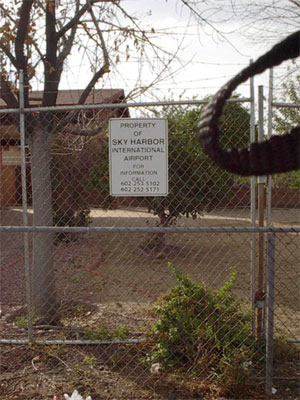
This does not mean, however, that there are not residences in which a sense of balance and harmony are not sought or attained. This home, while continuing to display the degree to which inside life is carried outside the front of the house (as opposed to the back-of-the-house patio and garden living of more typically Anglo tastes), nevertheless also displays a degree of tidiness and freshness that belies also the racist assertion that Chicano properties are unkempt and that demolition of such neighborhoods is nothing more than a reasonable effort to ride the city of infested blight.
Nevertheless, this photograph reveals two of the less than favorable shall we say aesthetic conditions residents must put up with: poorly maintained streets and proliferating power and telephone lines. Phoenix is a city that fights almost a losing battle to maintain streets that experience the deleterious effects of five or six months of unrelenting summer heat, and it n surprise that East Sherman Street is less well maintained than East Camelback Road. Reflecting, moreover, the age of the area and the lack of resources to bury service lines, residences are often framed, overlain, and crisscrossed with such lines. In addition, the residence below is foreground to the omnipresent detail of the overflights of aircrafts in the area.
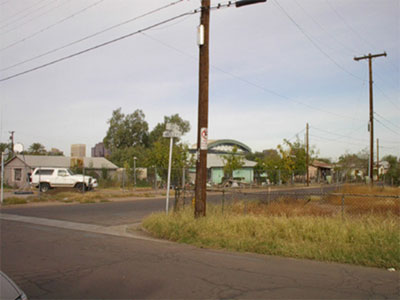
These overflights, the real bane, in terms of noise and vibration, of residential areas in the flight plane of one of the busiest airports in the nation, are additionally a constant remind of what is the impending fate of the remaining Nuestro Barrio area: its destruction in order to enable the expansion of that facility. The indicators of this destruction are everywhere, as Sky Harbor has gone about acquiring properties, posting warnings that they now belong to the airport, shuttering them.
Some dwellings have even now been torn down, with the inevitable warning that the property has an owner and that no trespassing or dumping will be allowed.
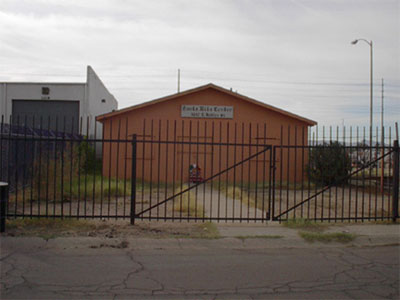
Such a process of urban growth, with little in the way of consideration for the impact that it will make on individual lives, particularly when these are the undervalued ones of ethnic minorities who are simply assumed unquestioningly to be illegal immigrants and therefore unworthy of respect or attention. Residents live in the omnipresent shadow of urban growth, some of the icons of which represent, in turn, the earlier disappearance of other ethnic neighborhoods. The pictures here also show how the neighborhood is literally overwhelmed by the Chase Field Ballpark, which is on the west side of Seventh Street, a constant reminder that the “real city” (that is, the Anglo city and its financial and commercial anchors, one manifestation of which are sports stadiums) is just over there, while at the same it is also a reminder that their area will also befall the same fate as the ethnic enclave displaced to build the ballpark, which, in this case, was what little was left of Phoenix’s original Chinatown, although it also included at the time some Chicano establishments. Indeed, one of the unresolved urban conflicts as I write this in late 2005 is the fate of the Sun Mercantile Building, the last remaining remnant of Chinatown. The Phoenix Historical Preservation Commission has recommended that the edifice, which dates from the 1920s, be left untouched with no surrounding new commercial development, while the City Council is inclining toward approving its incorporation into a high-rise hotel whose developers appear to have agreed to use it in part for a small museum of the history and culture of Chinese Americans. However, the ballpark stands there, along with other high-rise buildings in the background, as a sentinel of tax-generating commercial development and as a sign of what is likely to transpire.
Yet neighborhood life goes on, not only with the residences displaying all of the trappings of the day-to-day business of their occupancy and the human industry their elements display, but also in the presence of communal points of reference, such as a modest but impressively fenced-in religious center.
Just outside the East Sherman Street area stands an installation for a political activist group. The building is very attractive in its stylized Aztec imagery and is indicative of the energetic political involvement members of the Chicano community are striving to maintain. Yet it is significant that no Chicano sits on the Phoenix City Council and the representation of Chicanos—or Latinos—in the Arizona State Legislature is a long way from being representative of the approximately 33% percent of the population this group has grown to be. The disappearance of what is left of Nuestro Barrio appears to be an irreversible fact of urban history and, although this installation lies outside of the specific area destined for demolition and on one of the major thoroughfares through downtown Phoenix, Buckeye Road, which deadends to the east at the south edge of Sky Harbor International Airport, it is an open question whether it will escape the unrelenting political and economic forces that are bringing about the removal of the residential area featured in these photographs.
(1). Approximately a mile to the west is La Sonorita (the city calls it the Grant Park neighborhood), the oldest intact surviving Chicano neighborhood in Phoenix. See my illustrated article on this area with reference to its representation in a major work of Chicana fiction.
David William Foster is Regents’ Professor of Spanish and Women’s and Gender Studies Arizona State University, Tempe. E-mail: DAVID.FOSTER@asu.edu. David William Foster (Ph.D., University of Washington, 1964) is past Chair of the Department of Languages and Literatures and Regents’ Professor of Spanish , Women’s Studies and Interdisciplinary Humanities at Arizona State University. His research interests focus on urban culture in Latin America, with emphasis on issues of gender construction and sexual identity. He has written extensively on Argentine narrative and theater, and he has held teaching appointments in Argentina, Brazil, Chile, and Uruguay. His most recent publications include Violence in Argentine Literature; Cultural Responses to Tyranny (University of Missouri Press, 1995); Cultural Diversity in Latin American Literature (University of New Mexico Press, 1994); Contemporary Argentine Cinema (University of Missouri Press, 1992); and Gay and Lesbian Themes in Latin American Writing. Austin: University of Texas Press, 1991). He is also the editor of Latin American Writers on Gay and Lesbian Themes; A Bio-Critical Sourcebook (Greenwood Press, 1994). Sexual Textualities: Essays on Queer/ing Latin American Writing was published by the University of Texas Press in 1997. His most recent publications include: Culture and Customs of Argentina (1998; with Melissa Fitch Lockhart and Darrell B. Lockhart), A Funny Dirty Little War/no habrás más penas ni olvido (1998), and Buenos Aires: Perspectives on the City and Cultural Production (1998). He is also the editor of Spanish Writers on Gay and Lesbian Themes; A Bio-Critical Sourcebook (1999) and Chicano/Latino Homoerotic identities (1999).
_________________________________________________________________
Este texto y este portal es posible gracias al patrocinio de las comunidades mexicanas, chicanas y latinas de Estados Unidos y de la zona fronteriza con México; para continuar nuestra labor cultural en español, apreciamos su donativo vía PayPal, muchas gracias!











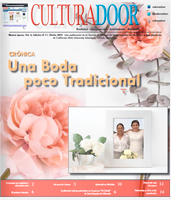
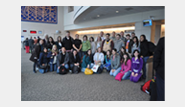

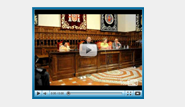


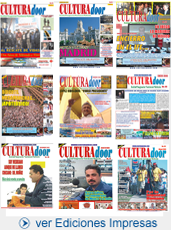
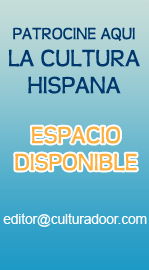






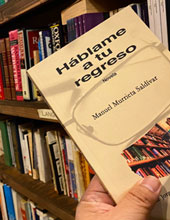
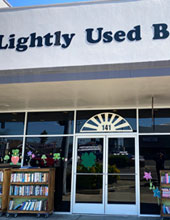
Por: Ivan en Oct 15, 2010
Interesante, no va a continuar con este art?culo?
Ivan
Por: constance deise en Feb 11, 2013
Hi, I have been trying to find out the color of the doors and the upper round window on Sacred Heart Catholic Church in the Golden Gate Barrio near the airport in Phoenix. Why can’t anyone answer this question? I am in the process of painting the church because I am a historic mini acrylic artist. This seems like a simple request.
¿Qué color esta la ventana círculo y las puertas enfrente de la Iglesia Sacred Heart? Por favor si puede ayudarme, escribe a mi e-mail. Voy a hacer una pintura histórica pequeña de la iglesia.
Thanks. Gracias.
Constance Harris Deise
http://www.etsy.com/shop/MiniPaintandInk?ref=si_shop
connied63@live.com